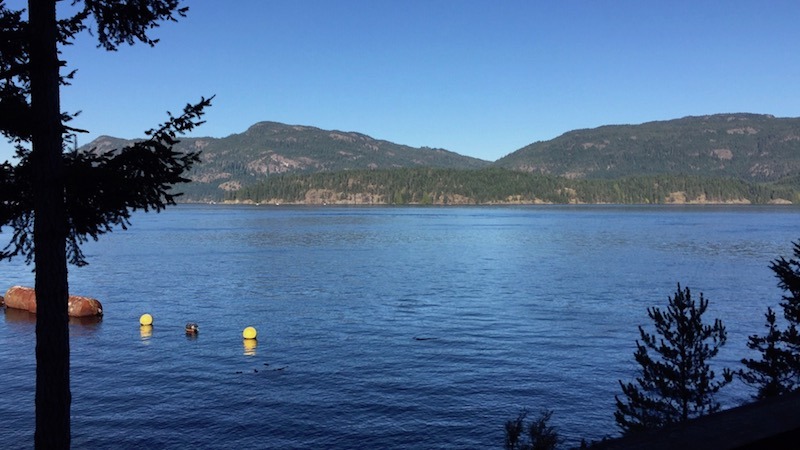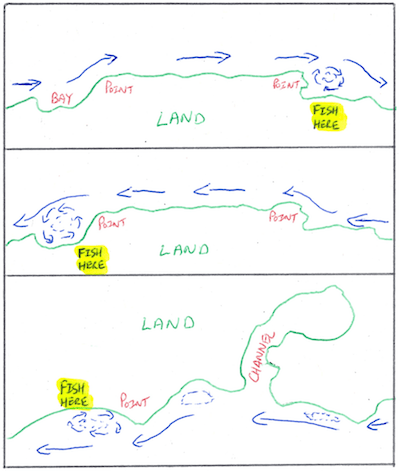
Have you ever wondered why some ocean fishing spots are so popular? The ocean has its own patterns, much like a river. The Salish Sea is no different.
I grew up fishing rivers where I caught salmonids by analyzing the terrain and current patterns in the river. In the river there are runs, pools, shorelines, back eddies, current seams and structure covers. Similar to the river, the ocean has flood and ebb tides that create tidal currents. Instead of the current coming from upstream to downstream, the flow is bi-directional. That creates unique bodies of water full of fishing potential.
A run in the river is fast-flowing water, sometimes located in the middle of the river. Runs are popular spots during the return of salmon, like the sockeye season in the Fraser River. From studying ocean charts, I have found that the Johnston Strait, Seymour Narrows, Lewis Channel and Hoskyn Channel are like a run of the river. During high flows, it will be challenging to troll in the middle, but during slack or slow current, it is fishable.
If you shift your focus towards the shoreline and ridges, there you will see slower tidal currents and features where salmon and other fish can be found. (See Figure 1 for illustration of run in Seymour Narrows and Plumper Bay.)

Figure 1: A figure of the run system in the river and ocean. Current seams and back eddies are formed by the wall structures. Potential regions where fishes gather are illustrated.
In the fast runs of the rivers, I have found fish swim near the shoreline and some rest behind boulders between travels. In the ocean, there are back eddies along the deep shoreline rock walls. These are terrains where fish and mammals can swim and also avoid holding against heavier flows of the tides. You will have to find where the tidal surge meets the back eddy, where it creates a seam on the surface of the water.
You want to fish between the seam and the rock wall. Keep in mind these are regions where you need to be comfortable with handling your boat. The tide will catch your boat’s bow and affect its heading. (See Figure 1 for illustration of current seam and back eddies created by points.)
Another feature creating a refuge for fish are contours of the submerged ridges in the ocean leading up to the shoals. Those ridges and contours will create a back eddy in which fish will hold. The shoals are a safe haven for fish to hide or escape from predators because of the marine vegetation that provides refuge.
Kelp beds, multiple ridges, and shelf contours are other terrains to seek out much like how the river has fallen trees and man-made structures where fish hold. (See Figure 2 example of structure and shoal.)
In the river there are pools. Likewise, in the ocean there are bays.
Pools in the river are slow moving with some back eddies. The bay has patterns with flood and ebb tides. In the bay where the tide forms a back eddy and seams, a slower body of water can be found. It is as a prime place in which fish hold.
Some bays fish better on the ebb tide and some on the flood. If you follow the back eddy and tidal seams that is where you will find fish. (See Figure 3 for examples of bay with different tide current creating fish holding spots.)
Studying ocean charts and how the tide reacts with terrain has proven successful for me. I hope my experience provides you a new perspective into ocean fishing.
A day out on the water is always fun and full of new experiences. Just remember to stay safe out on the water. There are plenty of fish for everyone to enjoy. Be respectful to other boaters and give room to those boats that have a fish on.
Fishing in the tidal waters can be dangerous. Please be comfortable with your boat before attempting to venture into unknown fishing terrains. Safety on the water is the highest priority. Always wear your personal flotation device and make sure your marine VHF radio is in good condition. It is always a fun day out on the water when everyone is safe.
Visit the Store
$34.99
$34.99
Featured Catch

Joel Unickow halibut (Photo: Rob Frawley Lucky Strike Sportfishing Tofino)










